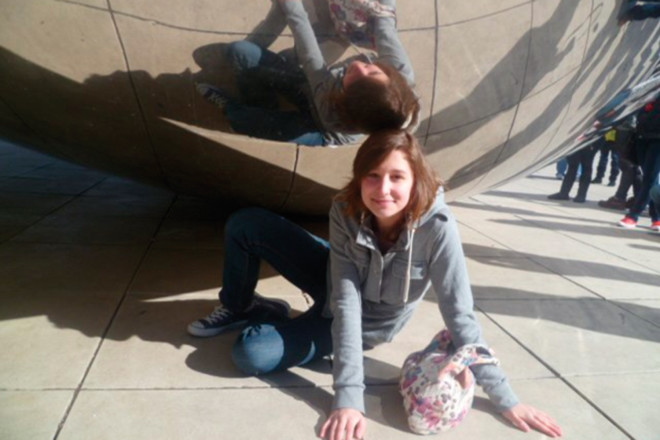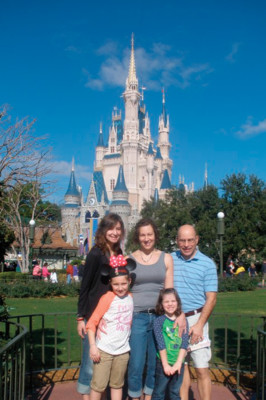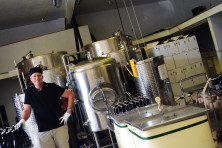Changing the World, One Student at a Time
- Share
- Tweet
- Pin
- Share

Every year, over 8,000 students broaden their worldview and establish lifelong friendships through Rotary Youth Exchange. The extensive network providing support to the program includes over 1.2 million Rotarians in more than 32,000 clubs worldwide. Rotary International has been coordinating exchanges since 1929 with a unified objective: to promote world peace and understanding, one student at a time.
Rotary Youth Exchange committee member Sue Anschutz observes, “The most notable attribute gained through the experience is the development of character: students learn to be open-minded to other cultures and traditions.” Through her own participation as an exchange student to Sweden in 1981, Sue found that “Every person has a story to tell. We can learn something from everyone.” She recalls evenings at the dinner table with her Swedish host family, where they learned from one another as they openly discussed their contrasting religious beliefs. Anschutz also remembers the impact of learning world history from the perspective of the Swedes while attending high school, offering “an entirely different way of looking at the world.”
The Rotary Youth Exchange program is highly selective and the application process typically begins 9 to 12 months before departure. Applicants are above-average students who have been endorsed by their teachers and have the “complete and unqualified support of their parents.” A key attribute sought by the selection committee is adaptability; exchange students must be open to new experiences and cultural differences. In addition, they must demonstrate leadership and confidence, with an ability to adjust to changing surroundings. Candidates are carefully selected following completion of a written application and extensive in-person interviews. They are then matched with a sponsoring local Rotary club.

Katy on vacation with her host family.
The selection process helps to ensure the program’s success by identifying candidates most likely to benefit from the experience. Because participants are identified months in advance of departure, there is ample time to prepare students for the exchange. Rotary expects student representatives to be active participants in the program, serving as ambassadors for their home country and being able to share information about their government, lifestyle, culture and ideas.
Rotary Youth Exchange committee member Sandy Hurley believes that “the success of Rotary Youth Exchange is grounded in the fact that we prepare students better than any other exchange program.” Many host clubs offer conferences and workshops leading up to the exchange through which outbound students meet other inbound and outbound program participants. Additionally, Rotary provides students with a support network in the host country as well as rebound programs to help students re-assimilate upon return. Activities throughout the year help to build camaraderie among the students, ensuring that they feel connected to the host club and the larger Rotary network.
According to Rotary Youth Exchange committee member Reeder Herrick, “Through the Rotary Youth Exchange program, participants interact with people from other countries and cultures and learn that at heart, they are good people just like us.” Everyone benefits from the experience: the students, the host family and the community in which they are placed, as well as the local community to which the students return.
Rotary Youth Exchange coordinates both long-term and short-term international exchanges in more than 150 countries and geographic areas, with destinations dependent on the home Rotary district. The long-term program is available to students ages 15 to 19; participants spend up to a year living with host families and attending school in a different country. They may learn a new language during their time abroad, but even more importantly they learn about themselves as they gain a new perspective on the world.
Short-term programs may also be available, depending upon the sponsoring club, with exchanges of a few days to several weeks. For example, the Rotary Club of Sturgeon Bay #2674 offers a summer program that is a direct family-to-family exchange, where two families alternatively host a student from the other family. Rotary’s New Generations Exchange program for students and young professionals ages 18 to 25 may involve homestays, tours, camps or internships and are typically three to six weeks.
Volunteers are the foundation of Rotary’s world-renowned exchange program. At the club, district and multidistrict level, Rotarians take care of the logistics that make the exchanges happen. They introduce students to other club members and organize social and cultural functions for them to attend. Rotarian counselors maintain ongoing contact with host families and students.
Through the support of these dedicated local volunteers, Rotary is able to keep participation costs low so even those with financial constraints can share the exchange experience. The host community arranges school enrollment and covers tuition, host families cover room and board, and local clubs may also provide a monthly stipend. Host families aren’t compensated financially, but are rewarded by the unforgettable and fulfilling experience of including the student in family, community and cultural events.
Rotary International has instituted a mandatory Certification Program that assesses individual programs for quality control and student safety. According to Rotary policies, “Each program has its own rules for participants to follow, but all Youth Exchange volunteers are devoted to the safety of students and host clubs and districts maintain policies and procedures to protect them.”
The local Sturgeon Bay Rotary Clubs offer an informational meeting every fall to provide details regarding Rotary Youth Exchange. The meeting is publicized with press releases and notices sent to the area high schools. Many parents attend to gather information years in advance so they can evaluate the program even before their students are ready to participate.
When asked what he sees in students following their year abroad, Reeder Herrick states, “The change I’ve consistently noticed is in their overall level of maturity. They learn to make decisions on their own. They discover their own capabilities to deal with challenges.” He continues, “Life in Door County – things are pretty much mapped out for them. Once abroad, however, they learn to make their own way. It may be the first time they have had to navigate an airport, or locate a train terminal by following signs in a new language. They find themselves in a unique position as a newcomer, making friends at school with people that initially view them as a foreigner.”
Sue Anschutz reflects on her year in Sweden where she lived with one family throughout the year and formed a very close bond. She is still in contact with that family today and has returned to visit several times. They have also traveled to visit her in the United States. Anschutz’s interest in the program was initially aroused by her sister who was a Rotary Youth Exchange student in Columbia. When her sister returned and expressed that it had been “the best year of her life,” Sue knew that she wanted the same opportunity.
Committee member Sandy Hurley sums up the value of the program as follows, “The Rotary Youth Exchange experience is the start of a life-long learning process. If everyone was an exchange student, we wouldn’t have the problems in the world that we do today. It is the kids that take away the barriers, they are the key to the future.”
In Their Words
The Rotary Club of Sturgeon Bay is currently hosting two inbound students, Katarína Froová (Katy) from Slovakia and Audrey Bernini from Brazil.
Katy sums up her thoughts about being an exchange student by saying, “It is one of the best things that has ever happened to me…I am getting experiences that anybody can only dream about. I am so lucky to be here, to spend one year with the nicest people in the world.” She sees positive changes in herself, commenting, “I am more confident than I was, I believe in myself more than I did and I believe in other people.”

Katy at her school.
Audrey also recognizes that she has matured from the experience, explaining, “In Brazil my parents could take care of me and here I need to take care of myself…I learned how to control my money, how to really take care of everything without someone doing things for me, I think that I’m totally different now after six months.”
Both Katy and Audrey encourage other students to participate by emphatically stating, “Just do it!” Katy suggests, “It is your turn to do the best you can…your exchange year is as good as you can make it. Don’t be afraid, you cannot lose.” Audrey comments, “I would encourage everyone to do it. It will be the best year of your life!” She adds, “It all depends of you, the country doesn’t matter at all, what matters is how you enjoy it.”
Speaking of her host families, Katy says, “These families are my basic point from which I have grown. They have given me so much! They gave me themselves.” Her heartfelt insight for families considering the opportunity: “It is the best thing you can do. You can give somebody a home and the person will be grateful for the rest of their life. You can influence somebody’s life as you never thought you would.”
Interested in Participating?
Those interested in participating as a student or host family may contact a local Rotarian or visit www.rotary.org for additional information. Door County Rotary clubs include: Rotary Club of Sturgeon Bay #2674 (Youth Exchange Chair – Dr. Kurt Scheer) and Sturgeon Bay Breakfast Rotary Club #28537. Both clubs are part of Rotary District 6220 (www.ridistrict6220.org), for which Matt Orthober serves as the Rotary Youth Exchange District Chairman. Inquiries may be directed to (920) 743-9667 or [email protected]
Supporting Rotary
Financial contributions in support of current inbound/outbound students are always welcome and may be coordinated through the local clubs. Donors may also consider contributions to the Rotary Foundation, which enables Rotarians to conduct projects addressing today’s challenges, including illiteracy, disease, hunger, poverty and environmental concerns. To learn more, visit www.rotary.org or contact the Foundation’s Contact Center at 1-866-9ROTARY (866-976-8279) or [email protected]




